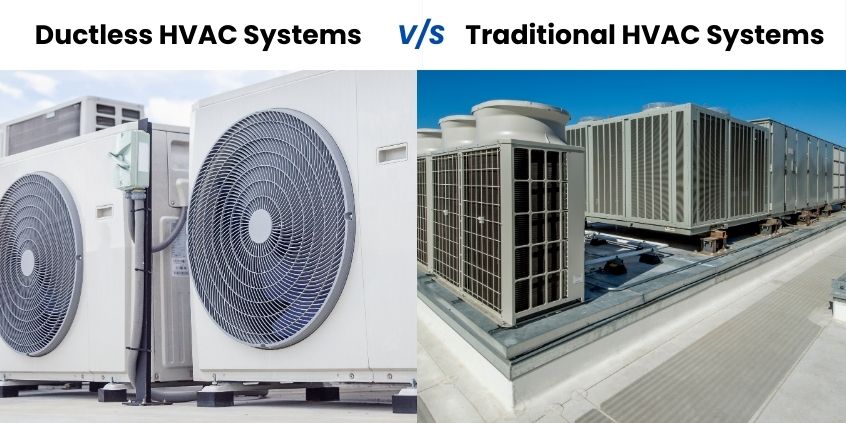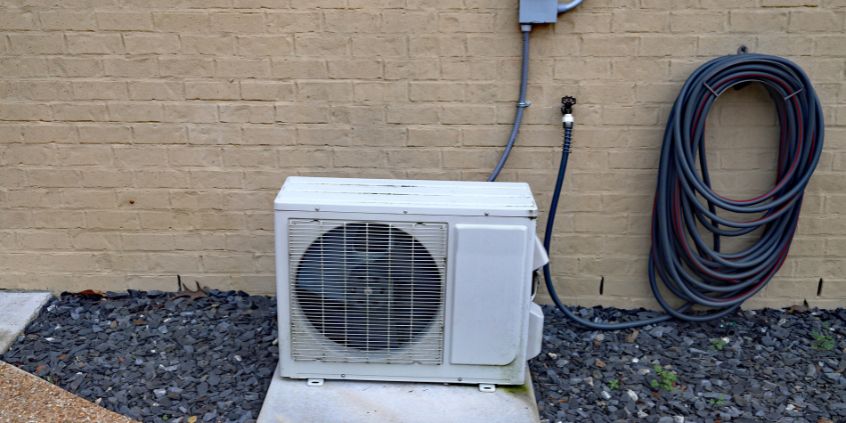Ductless mini split systems, also known as mini split AC or ductless HVAC systems, are compact cooling and heating systems that give room-by-room climate control without ductwork. It features easily installed and maintained all-in-one units that are both energy efficient and simple to service, with whisper-quiet operations.
What makes it different is that it enables independent “zone” control in each space efficiently. So, should you opt for this rather than the traditional HVAC system? Keep on reading to learn what’s what about ductless mini split systems
What Is a Ductless Mini-Split System?
A ductless mini-split routes refrigerant between an outdoor unit (compressor and condenser) and individual indoor units in each room. No ductwork is required — each indoor unit has its own blower fan, evaporator coil, filter, and controls.
The refrigerant lines, power wires, and drain are transported through a narrow duct connecting the indoor and outdoor units, as seen in the image below. And since there are no common ducts, each room has independent operation for customizable comfort wherever you are in the house.
Components of a Ductless Mini-Split System
There are several components of a ductless mini-split system, like:
- Indoor Unit (Air Handler): Contains the evaporator coil, blower fan, control board, and air filter for the room’s climate control. These units are usually wall- or ceiling-mounted and blow conditioned air directly into the space.
- Outdoor Unit (Compressor/Condenser): Houses the compressor, condenser coils, fan, and expansion valve that dissipate or collect heat outdoors. One outdoor unit can often support multiple indoor heads (commonly up to four or more).
- Refrigerant Line Set (Conduit): A small insulated conduit containing copper refrigerant tubing, power wiring, and a condensate drain line. This links each indoor unit to the outdoor unit.
- Controls: A wireless remote or wall-mounted thermostat is included for each indoor unit, enabling independent temperature settings per zone.
Advantages of Ductless Mini-Split Systems
- High Energy Efficiency: Mini-splits avoid 20–30% energy loss seen in ducted systems. High SEER-rated models consume less electricity and help cut long-term bills.
- Zoning and Comfort Control: Each indoor unit has a separate thermostat for individual rooms. You can cool used rooms and avoid wasting energy on empty ones.
- Easy, Flexible Installation: Requires just a small hole in the wall for pipes and wires. Indoor units are compact, and outdoor units can be placed up to 50 feet away.
- Quiet Operation: The units inside have little or no noise whatsoever. A normal usage may produce around 20–30 decibels. With the compressor outside, indoor comfort is not disturbed by loud sounds.
- Improved Air Quality (In Some Models): Built-in filters trap dust and allergens effectively. No ducts means no duct-borne dust or mold problems inside the home.
- Year-Round Heating & Cooling: Acts as both a cooler and a heater using heat pump technology. Offers better efficiency than standard electric heaters in winter.
Common Drawbacks of Ductless Mini-Split Systems
- Higher Upfront Cost: Ductless systems are costlier per unit compared to window ACs or basic central AC. Multi-zone setups can be expensive if many indoor units are needed.
- Multiple Visible Units: Each zone needs a separate indoor head, which may affect the interior look. Even sleek designs can clash with furniture or wall layout.
- Complex Installation Needs: Proper sizing and placement are very important to avoid short-cycling. Running refrigerant and power lines through walls requires skilled work.
- Limited Whole-House Ventilation: Mini-splits recirculate indoor air and don’t pull in fresh air by default. Extra ventilation systems or open windows may be required.
- Maintenance for Multiple Units: Each indoor head has its filter and coil to clean. This increases the maintenance effort compared to a single central unit.
- Cold-Climate Performance: In very low temperatures, mini-split heating may become less effective.
Ductless vs. Traditional HVAC Systems

When comparing ductless and traditional HVAC systems, the first thing that walls the two off from each other is that ductless heating and cooling systems do not use a single, central compressor and air handler to cool or heat air and then redistribute it on the rooms of the house through a series of ducts, like most central HVAC units do. This complicated HVAC system frequently results in a 20–30% loss in energy consumption from leaking ducts or a lack of insulation.
And when you compare it with ductless mini-splits, the setup includes an indoor unit directly in each room, which helps avoid such losses and usually offers better efficiency per ton of cooling.
You can say that central systems are better for covering large areas from a single unit and can support extras like air filters, humidifiers, and fresh-air intake. Mini-splits, though, are quieter and more practical for retrofits or adding cooling to specific areas without major renovation work.
Installation and Maintenance Tips
Here are some tips to consider:
- Always get the installation done by a trained professional.
- Drill a 2–3-inch hole through the exterior wall for the conduit.
- Mount indoor units high on the wall for better airflow.
- The size of the unit must be chosen carefully based on the room size.
- Avoid oversizing or undersizing to prevent energy loss or poor cooling.
- Place the outdoor unit on level ground or a sturdy wall bracket.
- There should be enough space for a clear flow of air around the outdoor unit.
- Keep leaves, snow, and debris away from outdoor coils.
- Clean indoor filters once a month or more often if dusty.
- Check and clean the indoor coil and condensate drain periodically.
- Trim vegetation near the outdoor unit regularly.
- Schedule annual professional servicing for a full system check-up.
- Call a technician if there is weak airflow or unusual noise.
Importance of Professional HVAC Consultation
Since ductless mini-splits need precise refrigerant handling and accurate sizing, it’s always better to get the work done by a certified HVAC technician. Professionals use proper tools to charge refrigerants, calculate load based on room size, and follow safety codes.
Many brands won’t honor the warranty if not installed by a licensed contractor. A proper installation avoids common issues like incorrect pipe sizing or poor electrical work and helps the system run efficiently for years.
Conclusion
Now you know everything about a ductless mini split system there is. So, whether you are a homeowner or business owner, selecting the right mini-split system that fits your space, budget, and climate needs is just one step away.
With proper planning and expert installation, a mini-split can be an efficient, flexible heating and cooling solution for many settings. Trust All About Air Conditioning & Heating LLC to help guide you through the process and ensure a smooth, professional installation.


